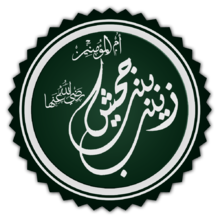宰娜卜·賓特·傑哈希
| 宰娜卜·賓特·傑哈希 | |
|---|---|
 | |
| 出生 | 592年 麥加 |
| 逝世 | 642年 麥地那 |
| 安葬於 | 巴奇(墓地) |
| 配偶 | 扎伊德·伊本·哈里沙、穆罕默德 |
宰娜卜·賓特·傑哈希(阿拉伯語:زينب بنت جحش,羅馬化:Zaynab bint Jaḥsh,590年641年—)是伊斯蘭教先知穆罕默德的姑表妹與第七位妻子。[1][2]
生平[編輯]
宰娜卜的父親傑哈希·本·利雅布是穆罕默德的同伴(薩哈巴)之一,母親烏瑪梅·賓特·阿布德·穆塔利卜則是古萊什部族首領阿布德·穆塔利卜之女,與穆罕默德父親阿卜杜拉為親兄妹。[3]
宰娜卜的第一段結婚在其皈依伊斯蘭教之前。丈夫姓名已不可考,不過記載他於622年去世。[4]那時她已是穆斯林,跟隨她的兄長從麥加遷移到麥地那。[5]
約625年,穆罕默德提出讓宰娜卜嫁給他的義子宰德‧本‧哈里達。宰德原是一位奴隸,曾被賣給穆罕默德髮妻赫蒂徹的一個侄子。後來赫蒂徹將他作為結婚禮物送給穆罕默德,穆罕默德則釋放了他並認其為義子。[4]貴族出身的宰娜卜一開始可能考慮到宰德曾經為奴的經歷而猶豫,但最終還是接受穆罕默德的提議,同意了這門婚事。[2][6]不過這樁婚姻僅維持了不到兩年便以離婚告終。[7]
離婚後不久宰娜卜再嫁給穆罕默德。這打破了當時阿拉伯社會將義子等同於血親、因而將娶義子前妻視為亂倫的傳統看法。[8][9]此後宰德的全名也從「宰德‧本‧穆罕默德」改回其本名「宰德‧本‧哈里達」。[4]穆罕默德為與宰娜卜結婚而打破傳統習俗的行為後來遭到了一些學者的批評。[10][11][12][13]627年3月27日,宰娜卜離婚後的待婚期剛一結束她就與穆罕默德成婚。[4]穆罕默德的另一位妻子阿伊莎後來提到宰娜卜是穆罕默德最喜愛的妻子之一。[3][14]
穆罕默德於632年去世後,宰娜卜從未再離開過麥地那。[3]大約九年之後,宰娜卜於約641年去世,是穆罕默德死後第一位離世的聖妻。[4]
參考文獻[編輯]
- ^ Gwynne, Paul. Buddha, Jesus and Muhammad: A Comparative Study. John Wiley & Sons. 2013. ISBN 978-1118465493.
- ^ 2.0 2.1 Abdulmalik ibn Hisham. Notes to Ibn Ishaq's "Life of the Prophet", Note 918. Translated by Guillaume, A. (1955). The Life of Muhammad, p. 793. Oxford: Oxford University Press.
- ^ 3.0 3.1 3.2 Muhammad ibn Saad, Kitab al-Tabaqat al-Kabir. Translated by Bewley, A. (1995). Volume 8: The Women of Madina. London: Ta-Ha Publishers.
- ^ 4.0 4.1 4.2 4.3 4.4 Muhammad ibn Jarir al-Tabari. Tarikh al-Rusul wa'l-Muluk. Translated by Landau-Tasseron, E. (1998). Volume 39: Biographies of the Prophet's Companions and Their Successors. Albany: State University of New York Press.
- ^ [Muhammad ibn Ishaq. Sirat Rasul Allah. Translated by Guillaume, A. (1955). Life of Muhammad, p. 215. Oxford: Oxford University Press.
- ^ Al-Jalalayn, Tafsir on Q33:36-38.
- ^ Maududi (1967), vol. 4, p. 112-3
- ^ "...the marriage of a man with the wife of his adopted son, even though divorced, was looked upon by the Arabs as a very wrong thing indeed." Sell, E. (1905). The Historical Development of the Quran, pp. 149–150. London: Society for Promoting Christian Knowledge.
- ^ "This liberality did not prevent severe comments from those who regarded adopted sonship as real sonship — for which view Mohammed’s institution of brotherhoods gave some support — and who, therefore, regarded this union as incestuous." Margoliouth, D. S. (1905). Mohammed and the Rise of Islam, Third Edition, p. 321. New York: G. P. Putnam’s Sons.
- ^ Hughes, T. P. (1885). A Dictionary of Islam: Being a Cyclopædia of the Doctrines, Rites, Ceremonies, and Customs, together with the Technical and Theological Terms, of the Muhammadan Religion. London: W. H. Allen & Co.
- ^ Tisdall, W. S. C. (1911). The Original Sources of the Qur』ân (pp. 278–279). London: Society for Promoting Christian Knowledge.
- ^ Tisdall, W. S. C. (1895). The Religion of the Crescent, or Islâm: Its Strength, Its Weakness, Its Origin, Its Influence. Non-Christian Religious Systems (p. 177). London: Society for Promoting Christian Knowledge.
- ^ Muir, W. (1861). The Life of Mahomet, Vol. 3, p. 231. London: Smith, Elder and Co.
- ^ Bukhari 5:59:462.
| |||||||||||||||||
